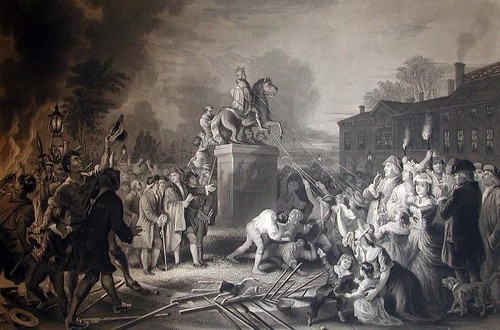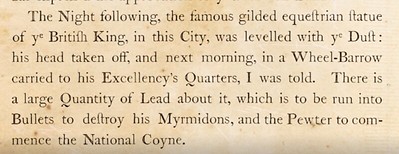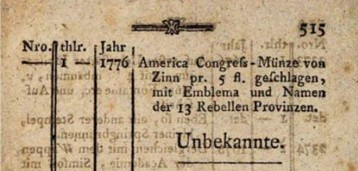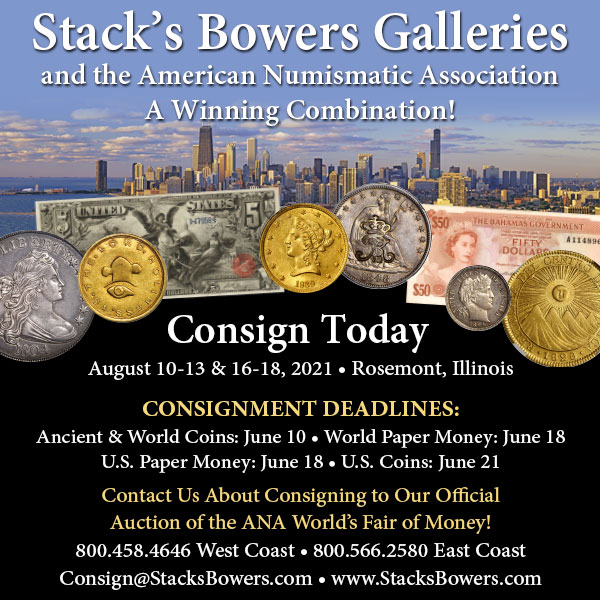
PREV ARTICLE
NEXT ARTICLE
FULL ISSUE
PREV FULL ISSUE
NO STATUE WAS HARMED TO MAKE CONTINENTALSApril 1st is behind us. We were more low-key about April Fool's Day this year, with just one item courtesy the Newman Numismatic Portal. That new Continental dollar evidence? Sorry, April Fool! There's no evidence that the coins were struck from metal from the statue of King George III destroyed by a mob of New York City patriots in 1776. -Editor Bill Eckberg writes: "The image of the "collector" who bought the arm and hand was my first clue. The ending gave it away. "Lianna's a really good straight-faced satirist." Relic pieces such as the 1792 "Liberte Francoise" medal and VIGO coinage of course exist, as do piece parts of the destroyed 1770 George III equestrian statue. Collector "Rex Robertson" does not exist, and no energy dispersive spectroscopy tests have been done comparing the statue's metal to the Continental Dollar coins. The "Solomon Drowne" letter was made up, too, but Sarah Sophia Banks' flyer about "These American Medals" is real. -Editor Julia Casey writes: "Your April Fools joke was a masterpiece! I thought it looked a little strange because you couldn't click through anywhere to see the source of the Drowne letter - but it was quite convincing! I thought the video would be an overview of all the past writings on the history of the Continental Dollar and didn't realize that it was about that topic so I didn't watch it until after I was somewhat fooled! But then I knew. Well played by all of you!" On a related note Bob Leonard writes: "The appearance of a Continental dollar in a collection formed in Germany in the 1780s is further evidence, if any were needed, that the 1776-dated Continental dollar was made in Europe in the 1780s, if not actually in Germany; no Western Hemisphere coins after 1773 were included. As discovered by Eric P. Newman and Maureen Levine, the earliest illustration of a Continental dollar is in Germany in 1783 (The Numismatist July 2014, pp. 38-41). "I can't agree with Ralf Böpple's speculation that it was "possible" for a Continental dollar to arrive from the United States in 1776, when they were already to be seen in Germany in 1783, two years prior to the auction. "In my opinion the Continental dollar is a speculation by a private mint in 1783 in the hope of obtaining a contract to strike coins for the United States, now that peace was finally at hand. The 1776 date was simply copied from Continental currency. The patterns were struck in pewter since it was anticipated that many would need to be distributed to members of Congress. If "E.G." can be identified we should be able to confirm this." Regarding the word "Unbekannt" below the Continental Dollar entry, Ralf Böpple wrote: "The only non-European non-Colonial coin is our Continental dollar, listed last in the "miscellaneous" section, right above the very last two entries, which are unknown items ("Unbekannt")." Herman Blanton agrees. He writes: "In the 1785 catalog the mention of "unbekannte" does not apply to the subject item. Unbekannte is the header for the items following which had unknown attribution. The 1776 "dollar" is listed under miscellaneous." Regarding Martin Purdy's translation of "geschlagen", Alan Luedeking writes: "geschlagen" means struck. (As opposed to cast, I presume.)" Thomas Lovelace writes: "I am thinking this might be a group lot - 1 minted in pewter and 5 struck in silver.
"Zinn - pewter
Craig Sholley submitted these thoughts on the longevity and staying power of the Continental Dollar in the U.S. numismatic world. Thanks. -Editor
The Origin of the Continental Dollar: Historically Curious and Functionally Irrelevant
I found the musings on the Continental Dollar in the past couple issues of The E-Sylum quite interesting, especially Julia Casey's discovery of a listing in a German catalog and the reader responses. However, it suddenly dawned on me that the whole controversy over their origin is, aside from just knowing, actually quite irrelevant. Auction records and dealer listings show that these pieces have been avidly collected in the U.S. for over 160 years. Furthermore, as the Sarah Sophia Banks collection and German catalogs clearly show, they were collected as soon as they appeared. As to more modern references, the Continental Dollars have been listed in the "Red Book" for as long as I can recall. The grading services certify them and list them in the "registry sets." None of that is going to change even if someone finds irrefutable proof they were made in Europe (for the record, that's what I believe, which is probably even more irrelevant than the evidence either way). A casual review of the "Red Book" and the grading services' web sites shows why. All of those sources list numerous non-U.S. coins as part of the U.S. series. For example, in the Post- Colonial section of the Red Book, we find a number of English "Conder" tokens including the so- called "Kentucky" token (which was definitely not struck in Kentucky or anywhere else in the U.S.), the "Franklin Press" token, and the Talbot, Alum, and Lee token. I seriously doubt that anyone reading an edge inscription such as "Payable At Liverpool" thinks this means Liverpool, PA. Then we have numerous Washington pieces having no denomination and known to have been struck in England, most likely as commemorative tokens. While some may have been used as coins, most were simply keepsakes. I could go on, but I think everyone gets the point by now - there are numerous non-U.S. medallions and tokens collected as part of the U.S. coin series simply because they have U.S. themed devices. The Continental Dollar is no different and should be treated no differently. For those who may feel the Continental Dollar should be "de-listed," that is a practical impossibility at this point. There is simply too much precedence to do so. Further, if this piece is to be "de-listed" because it is not of U.S. origin, then all non-U.S. pieces need to be de-listed. To do otherwise would be manifestly unfair and prejudicial against this one piece and those who choose to collect them. That is obviously not going to happen. Enjoy the historical discussion and be "pro" or "con" as you choose. But please realize it is very unlikely to have any practical effect on the collectability of these pieces. That die was cast over two centuries ago. The 1913 Liberty Nickel is a made-up coin, but that doesn't keep it from being an interesting multi-million dollar rarity, and I'm looking forward to John Dannreuther's new book. The Continental coins/medals/whatevers will continue to fascinate, and the discussions and investigations over their origins only make them more fascinating. Maybe I'm hanging in the wrong circles, but I haven't heard any calls for delisting and wouldn't expect that to happen. Thanks. everyone! Great discussion. -Editor
To read the earlier E-Sylum articles, see:
Wayne Homren, Editor The Numismatic Bibliomania Society is a non-profit organization promoting numismatic literature. See our web site at coinbooks.org. To submit items for publication in The E-Sylum, write to the Editor at this address: whomren@gmail.com To subscribe go to: https://my.binhost.com/lists/listinfo/esylum All Rights Reserved. NBS Home Page Contact the NBS webmaster 
|




